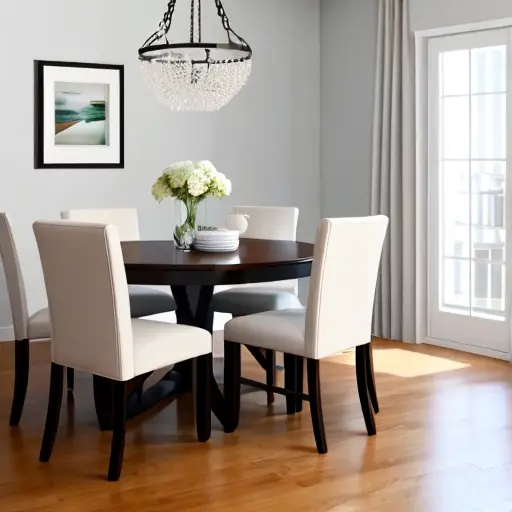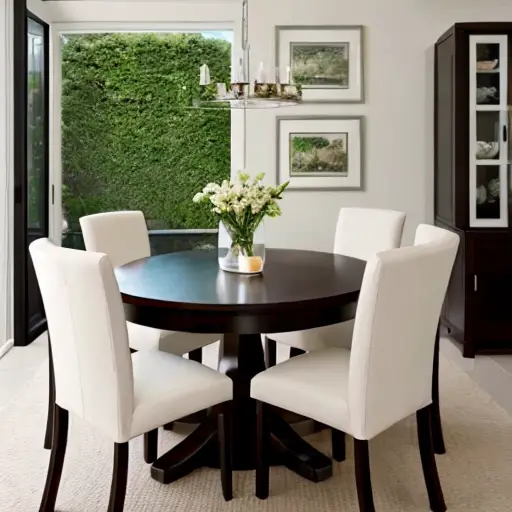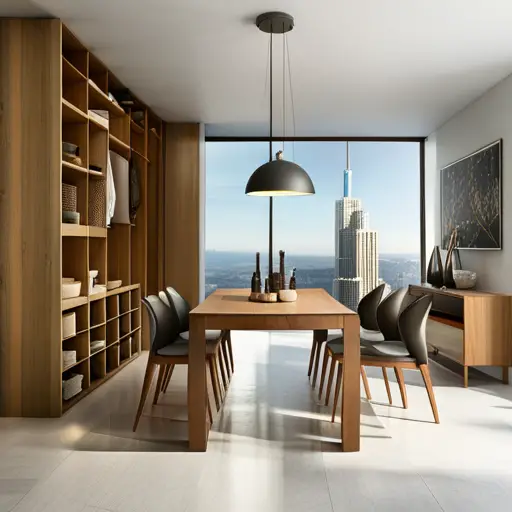Creating an optimized and efficient dining room layout can significantly enhance your space’s functionality and aesthetic appeal. Whether you have a small dining room or want to maximize the vertical space available, implementing smart optimization tips can make a difference. This article will explore vertical space optimization tips for dining room to help you make the most of your available space. From clever storage solutions to creative design ideas, we have you covered!
Utilize Wall-Mounted Shelves and Cabinets
One effective way to optimize vertical space in your dining room is by utilizing wall-mounted shelves and cabinets. Installing shelves or cabinets on the walls allows you to free up valuable floor space while creating additional storage options. These can be used to display decorative items, store tableware, or showcase your collection of wine glasses. Consider using floating shelves to add a touch of elegance to your dining room.
Hang Pendant Lights
Consider hanging pendant lights to make the most of your vertical space while adding a stylish element to your dining room. Pendant lights provide functional lighting and serve as decorative pieces that draw the eye upward, creating the illusion of a higher ceiling. Choose pendant lights that complement your dining room decor and add a warm and inviting ambiance.

Install a Wall-Mounted Foldable Table
If you have a small dining room or limited space, installing a wall-mounted foldable table is an excellent space-saving solution. This type of table can be folded against the wall when not in use, freeing up valuable floor space. Unfold the table and use it as a dining surface when needed. It is a practical and versatile option for optimizing vertical space in compact dining areas.
Choose Slim and Vertical Furniture
Opt for slim and vertical pieces when selecting furniture for your dining room. Instead of bulky chairs, choose sleek chairs that take up less space. Consider bar stools or chairs with slim profiles that can easily tuck under the dining table when not in use. Also, choose a dining table with slender legs or a pedestal base, which can create a sense of openness in the room.
Use Mirrors to Create Illusion of Space
Mirrors are a fantastic tool for creating the illusion of space in any room, including the dining room. By strategically placing mirrors on the walls, you can reflect light and give the impression of a larger, more open area. Hang a large mirror opposite a window to maximize the natural light entering the room. This simple trick can make your dining room appear more spacious and airy.
Opt for Transparent Furniture
Consider using transparent furniture to maintain a sense of openness and optimize vertical space in your dining room. Transparent or glass dining tables and chairs create a visual illusion of space, making the room more expansive. The transparent nature of these pieces allows light to pass through, further enhancing the openness and brightness of the dining area.
Utilize Corners with Corner Shelves
Corner shelves are an excellent way to utilize often-overlooked spaces in the dining room. Install corner shelves that extend vertically from floor to ceiling, providing ample storage and display space for books, decorative items, or plants. You can optimize space by utilizing corners without infringing on the main dining area.
Invest in a Built-in Banquette
Consider investing in a built-in banquette if you have limited space but want to accommodate more people in your dining room. A built-in banquette is a seating option that can be customized to fit your space perfectly. Utilizing a corner or a wall can create a comfortable seating area that maximizes vertical space while offering additional storage underneath the seats.
Use Vertical Storage Solutions
Vertical storage solutions are essential for optimizing the space in your dining room. Utilize tall bookshelves, cabinets, or armoires to maximize the vertical space available. These storage solutions can store dishes, glassware, table linens, and other dining essentials. Consider adding decorative baskets or bins to keep items organized and easily accessible.
Hang Artwork Strategically
Artwork can add personality and style to your dining room while optimizing vertical space. Hang artwork strategically on the walls to draw the eye upward and create the illusion of higher ceilings. Choose artwork that complements the overall theme of your dining room and adds visual interest to the space. This can be an excellent opportunity to showcase your favorite pieces or support local artists.
Create a Vertical Herb Garden
If you love fresh herbs and want to incorporate greenery into your dining room, consider creating a vertical herb garden. Install wall-mounted planters or shelving units where you can grow your favorite herbs. Not only does this optimize vertical space, but it also adds a touch of nature to your dining area, creating a fresh and inviting atmosphere.
Optimize Under-Utilized Spaces
In many dining rooms, under-utilized spaces can be optimized for storage or functionality. For example, the area underneath the stairs or between windows can be transformed into useful storage areas. Install custom-built shelves or cabinets to make the most of these unique spaces. This lets you keep your dining room clutter-free while utilizing every available space.

Create a Display Wall for Plates and Utensils
Instead of hiding your beautiful plates and utensils in closed cabinets, create a display wall to showcase them. Install open shelving on a blank wall and arrange your plates, bowls, and utensils in an organized and visually appealing manner. This optimizes vertical space and adds a decorative element to your dining room. It allows you to easily access and display your dinnerware while adding a personalized touch to the space.
Incorporate a Hanging Wine Rack
If you enjoy a glass of wine with your meals, consider incorporating a hanging wine rack in your dining room. A hanging wine rack can be installed on a wall or from the ceiling, saving valuable counter or floor space. It optimizes vertical space and adds a stylish and sophisticated touch to your dining area. Choose a wine rack that complements your dining room decor and showcases your wine collection.
Use a Rolling Bar Cart
A rolling bar cart is a versatile and practical addition to any dining room, especially if you have limited space. It can be easily moved around and provides additional storage for glasses, bottles, and other bar essentials. When not used, the rolling bar cart can be neatly tucked away in a corner, optimizing vertical space and maintaining a clutter-free dining area.
Install Window Treatments Strategically
Window treatments can play a significant role in optimizing vertical space in your dining room. Choose curtains or blinds that extend from the ceiling to the floor, creating the illusion of taller windows and higher ceilings. This vertical emphasis draws the eye upward, making the room appear more spacious. Additionally, opt for light-colored window treatments that allow natural light to filter in, further enhancing the brightness and openness of the space.
Incorporate Foldable Furniture
Incorporate foldable furniture into your dining room design to maximize flexibility and optimize vertical space. Foldable tables, chairs, or benches can be easily collapsed and stored away when not in use, freeing up valuable floor space. This is particularly useful in small dining rooms or when hosting larger gatherings. Foldable furniture provides functionality without compromising on style or comfort.
Choose a Statement Chandelier
A statement chandelier can be the centerpiece of your dining room while also optimizing vertical space. Choose a chandelier that hangs low enough to create a visual focal point but still maintains an appropriate distance from the dining table. This draws the eye upward and adds a touch of elegance and sophistication to the space. Select a chandelier that complements the overall style of your dining room.
Opt for Built-in Storage Benches
Built-in storage benches are functional and provide an opportunity to optimize vertical space. Install benches along the walls of your dining room with built-in storage compartments underneath the seats. This provides an excellent solution for storing dining essentials such as table linens, serving platters, or extra seating cushions. The benches also offer additional seating options while maintaining a streamlined and organized dining area.
Use the Space Above the Cabinets
In many dining rooms, the space above cabinets often needs to be used. Take advantage of this vertical space by placing decorative items, artwork, or additional storage baskets above the cabinets. This optimizes space and adds a decorative element to your dining room design. Ensure the items you place are proportional to the height of the cabinets to create a visually pleasing display.
Incorporate Multi-Functional Furniture
Multi-functional furniture is a smart choice when optimizing vertical space in your dining room. Look for dining tables with built-in storage compartments or extendable leaves that can accommodate extra guests. Additionally, consider chairs with hidden storage or benches that can be used for seating and as storage units. By incorporating multi-functional furniture, you can maximize space while adding versatility to your dining area.
Install a Wall-Mounted Drop-Leaf Table
A wall-mounted drop-leaf table is a practical and space-saving solution for small dining rooms. This type of table can be folded down when unused, taking up minimal space against the wall. When you need a dining surface, fold down the table, and it provides ample space for your meals. This compact and efficient design allows you to optimize vertical space without compromising functionality.
Incorporate Open Shelving
Open shelving is an excellent way to optimize vertical space while adding a decorative element to your dining room. Install open shelves on empty walls and use them to display decorative items, plants, or cookbooks. This enhances the visual appeal of your dining room and provides convenient storage for frequently used items. Organize the shelves as aesthetically pleasing to create a visually balanced display.

Utilize the Underside of the Dining Table
To optimize vertical space in your dining room, consider utilizing the underside of the dining table. Install hooks or a small hanging storage unit underneath the table to store table linens, placemats, or lightweight chairs. This clever solution allows you to free up space in other dining room areas while keeping essential items easily accessible.
FAQs
How can I make a small dining room feel bigger?
To make a small dining room feel bigger, you can:
- Use light-colored paint or wallpaper to create an illusion of space.
- Hang mirrors strategically to reflect light and create the illusion of higher ceilings.
- Opt for transparent or glass furniture to maintain a sense of openness.
- Install proper lighting to brighten up the room.
- Choose furniture with slim profiles to maximize floor space.
What are some creative storage solutions for dining rooms?
Some creative storage solutions for dining rooms include:
- Wall-mounted shelves and cabinets.
- Corner shelves to utilize under-utilized spaces.
- Built-in banquette with storage underneath.
- Vertical storage solutions such as tall bookshelves or armoires.
- Open shelving for displaying and organizing items.
How can I incorporate greenery into my dining room?
You can incorporate greenery into your dining room by:
- Creating a vertical herb garden on a wall.
- Placing potted plants on shelves or window sills.
- Hanging planters from the ceiling or walls.
- Adding a centerpiece with fresh flowers or succulents.
What type of lighting is best for a dining room?
The type of lighting that is best for a dining room includes:
- Pendant lights for focused lighting and decorative appeal.
- Chandeliers as a statement piece and to create ambiance.
- Wall sconces for additional lighting and to highlight the artwork.
- Dimmable lights adjust the mood for different occasions.
How can I optimize space in a dining room with limited square footage?
To optimize space in a dining room with limited square footage, you can:
- Use foldable furniture that can be easily stored away.
- Utilize vertical storage solutions such as tall cabinets or shelves.
- Install a wall-mounted foldable table that can be folded up when not in use.
- Incorporate multi-functional furniture, such as dining tables with storage compartments.
- Hang pendant lights or chandeliers to draw the eye upward and create a sense of space.
How can I add personality to my dining room while optimizing vertical space?
To add personality to your dining room while optimizing vertical space, you can:
- Hang artwork strategically on the walls.
- Incorporate decorative items or collections on open shelves.
- Choose unique and stylish furniture pieces.
- Install a statement chandelier or pendant lights.
- Use window treatments that complement your style.
How do you maximize vertical space?
To maximize vertical space in a room, consider the following tips:
- Utilize wall-mounted shelves or cabinets to create additional storage options.
- Hang pendant lights to draw the eye upward and create the illusion of a higher ceiling.
- Install a wall-mounted foldable table that can be folded up when not in use.
- Choose slim and vertical furniture pieces to save floor space.
- Use mirrors strategically to reflect light and make the room appear more spacious.
- Opt for transparent or glass furniture to maintain a sense of openness.
- Utilize corner spaces with corner shelves or storage units.
- Invest in built-in storage solutions such as banquette seating with storage underneath.
- Use vertical storage solutions like tall bookshelves or cabinets.
- Hang artwork strategically to create a vertical emphasis and add visual interest.
How to decorate a vertical room?
When decorating a vertical room, consider the following ideas:
- Choose furniture with vertical lines and slim profiles to enhance the verticality of the space.
- Use tall bookshelves or floor-to-ceiling curtains to create a sense of height.
- Incorporate vertical artwork or wall hangings to draw the eye upward.
- Use mirrors on the walls to create the illusion of a larger and more open space.
- Opt for long, vertical stripes in wallpapers or paint to elongate the walls.
- Hang pendant lights or chandeliers at varying heights to add visual interest.
- Utilize vertical storage solutions such as floating shelves or wall-mounted cabinets.
- Consider incorporating hanging plants or a vertical herb garden for a touch of greenery.
- Use tall vases or sculptures to add vertical elements to tabletops or shelves.
- Create a gallery wall with vertically aligned frames or artwork.
How do you use vertical shelf space?
To make the most of vertical shelf space, follow these tips:
- Organize items in vertical stacks or rows to maximize the use of space.
- Use vertical dividers or bookends to keep items upright and prevent them from falling over.
- Consider using bins or baskets that stack vertically to store smaller items.
- Utilize adjustable shelving units that allow you to customize the height between shelves.
- Arrange items based on the frequency of use, placing frequently accessed items at eye level.
- Use clear storage containers or labeled boxes to keep items organized and visible.
- Incorporate decorative elements like vases, picture frames, or plants to add visual interest.
- Consider using bookshelves with built-in drawers or cabinets for additional storage.
- Group similar items together to create a cohesive and organized look.
- Leave some empty space between items to avoid a cluttered appearance.
How do you maximize a room layout?
To maximize a room layout, consider the following strategies:
- Determine the focal point of the room and arrange furniture around it.
- Optimize traffic flow by leaving clear pathways between furniture pieces.
- Use multipurpose furniture that serves more than one function to save space.
- Consider the scale and proportion of furniture to ensure it fits the room appropriately.
- Utilize vertical space by incorporating wall-mounted shelves, cabinets, or hanging storage.
- Arrange furniture to create zones or designated areas for different activities.
- Use rugs or lighting fixtures to define different areas within an open-concept space.
- Consider built-in storage solutions to maximize storage capacity without sacrificing floor space.
- Opt for furniture with hidden storage compartments to keep the room clutter-free.
- Experiment with different furniture arrangements to find the most functional and visually appealing layout for your specific needs.
Conclusion
Optimizing vertical space in your dining room is essential for creating a functional and visually appealing space. By implementing the 25 tips in this article, you can maximize your available space and enhance the dining experience. From utilizing wall-mounted shelves and cabinets to incorporating multi-functional furniture, there are numerous ways to optimize your dining room’s vertical space. Remember to personalize the space with your style and preferences, making it a warm and inviting area for family and friends to gather.

